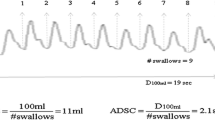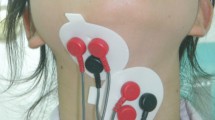Abstract
Oropharyngeal dysphagia and esophageal motility disorders were found to be the most important causes of aspiration pneumonia in patients with myotonic dystrophy. The purpose of this report was to evaluate clinical characteristics of the oral motor movements and swallowing of individuals with myotonic dystrophy type 1 (DM1) using a standardized clinical protocol and surface electromyography (sEMG). Participants were 40 individuals divided in two groups: G1 composed of 20 adults with DM1 and G2 composed of 20 healthy volunteers paired by age and gender to the individuals in G1. Statistical analysis included one-way ANOVA with two factors for within- and between-group comparisons and Bonferroni correction for multiple comparisons. Patients with DM1 presented deficits in posture, position, and mobility of the oral motor structures, as well as compromised mastication and deglutition. The sEMG data indicated that these patients had longer muscle activations during swallowing events. The longer duration of sEMG in the group of patients with DM1 is possibly related to myotonia and/or incoordination of the muscles involved in the swallowing process or could reflect a physiological adaptation for safe swallowing.
Similar content being viewed by others
References
Harley HC, Brook JD, Rundle SA, et al. Expansion of an unstable DNA region and phenotypic variation in myotonic dystrophy. Nature. 1992;355(6360):545–6.
Shaw DJ, Harper PS. Myotonic dystrophy: developments in molecular genetics. Br Med Bull. 1989;45(3):745–59.
Harley HG, Rundle SA, MacMillan JC, et al. Size of the unstable CTG repeat sequence in relation to phenotype and parental transmission in myotonic dystrophy. Am J Hum Genet. 1993;52(6):1164–74.
Mathieu J, Allard P, Potvin L, et al. A 10 year study of mortality in a cohort of patients with myotonic dystrophy. Neurology. 1999;52(8):1658–62.
Yotova V, Labuda D, Zietkiewicz E, et al. Anatomy of a founder effect: myotonic dystrophy in Northeastern Quebec. Hum Genet. 2005;117(2–3):177–87.
Gagnon C, Chouinard MC, Laberge L, et al. Health supervision and anticipatory guidance in adult myotonic dystrophy type 1. Neuromuscul Disord. 2010;20(12):847–51. doi:10.1016/j.nmd.2010.08.006.
Peñarrocha M, Bagán JV, Vilchez J, et al. Oral alterations in Steinert’s myotonic dystrophy: a presentation of two cases. Oral Surg Oral Med Oral Pathol. 1990;69(6):698–700.
Mercier J, Bennani F, Ferri J, et al. Maxillofacial manifestations of Steinert’s myotonic dystrophy. Rev Stomatol Chir Maxillofac. 1995;96(2):74–82.
Sovari AA, Bodine CK, Farokin F. Cardiovascular manifestation of myotonic dystrophy-1. Cardiol Rev. 2007;15(4):191–4. doi:10.1097/CRD.0b013e318070d1a7.
Ramig LA, Scherer RC, Titze IR, et al. Acoustic analysis of voice of patients with neurologic disease: rationale and preliminary data. Ann Otol Rhinol Laryngol. 1988;97(2 Pt 1):164–72.
Salomonson J, Kawamoto H, Wilson J. Velopharyngeal incompetence as the presenting symptom of myotonic dystrophy. Cleft Palate J. 1988;25(3):296–300.
Weinberg B, Bosma JF, Shanks JC, et al. Myotonic dystrophy initially manifested by speech disability. J Speech Hear Disord. 1968;33(1):51–9.
de Swart BJ, van Engelen BG, van de Kerkhof JP, et al. Myotonia and flaccid dysarthria in patients with adult onset myotonic dystrophy. J Neurol Neurosurg Psychiatry. 2004;75(10):1480–2. doi:10.1136/jnnp.2003.032151.
Darley FL, Aronson AE, Brown JR. Motor speech disorders. Philadelphia: WB Saunders; 1975.
McNeil MR. Clinical management of sensorimotor speech disorders. Stuttgart: Thieme; 1997.
de Die Smulders CE, Höweler CJ, Thijs C et al. Age and causes of death in adult-onset myotonic dystrophy. Brain. 1998;121:1557-63.
Mizuno T, Komaki H, Sasaki M, et al. Efficacy and tolerance of gastrostomy feeding in Japanese muscular dystrophy patients. Brain Dev. 2012;34:756–62. doi:10.1016/j.braindev.2011.11.012.
Peric S, Rakocevic-Stojanovic V, Basta I, et al. Influence of multisystemic affection on health-related quality of life in patients with myotonic dystrophy type 1. Clin Neurol Neurosurg. 2013;115(3):270–5. doi:10.1016/j.clineuro.2012.05.015.
Bellini M, Biagi S, Stasi C, et al. Gastrointestinal manifestations in myotonic muscular dystrophy. World J Gastroenterol. 2006;12:1821–8.
Harvey JC, Sherbourne DH, Siegel CI. Smooth muscle involvement in myotonic dystrophy. Am J Med. 1965;39:81–90.
Ertekin C, Yüceyar N, Aydogdu I, et al. Electrophysiological evaluation of oropharyngeal swallowing in myotonic dystrophy. J Neurol Neurosurg Psychiatry. 2001;70(3):363–71. doi:10.1136/jnnp.70.3.363.
Chiappetta AL, Oda AL, Zanoteli E et al. Oropharyngeal dysphagia in the myotonic dystrophy: phonoaudiological evaluation and nasofibrolaryngoscopical analysis. Arq Neuropsiquiatr. 2001;59(2-B):394–400.
Turner C, Hilton-Jones D. The myotonic dystrophies: diagnosis and management. J Neurol Neurosurg Psychiatry. 2010;81(4):358–67. doi:10.1136/jnnp.2008.158261.
Eisenhuber E, Schima W, Schober E, et al. Videofluoroscopic assessment of patients with dysphagia: pharyngeal retention is a predictive factor for aspiration. AJR Am J Roentgenol. 2002;178(2):393–8.
Ertekin C, Aydogdu I, Yüceyar N. Piecemeal deglutition and dysphagia limit in normal subjects and in patients with swallowing disorders. J Neurol Neurosurg Psychiatry. 1996;61(5):491–6.
Vaiman M. Standardization of surface electromyography utilized to evaluate patients with dysphagia. Head Face Med. 2007;3:26. doi:10.1186/1746-160X-3-26.
Ertekin C, Aydogdu I, Yüceyar N, et al. Electrodiagnostic methods for neurogenic dysphagia. Electroencephalogr Clin Neurophysiol. 1988;109(4):331–40.
Alfonsi E, Veríssimo M, Merlo IM, et al. Electrophysiologic patterns of oral-pharyngeal swallowing in parkinsonian syndromes. Neurology. 2007;68(8):583–90.
Coriolano MD, Belo LR, Carneiro D, et al. Swallowing in patients with Parkinson’s disease: a surface electromyography study. Dysphagia. 2012;27(4):550–5. doi:10.1007/s00455.012-9406-0.
American Speech-Language-Hearing Association. National Outcome Measurement System (NOMS). Adult Speech-Language Pathology training manual. Rockville, MD: ASHA; 1998.
Wesling M, Brady S, Jensen M, et al. Dysphagia outcomes in patients with brain tumors undergoing inpatient rehabilitation. Dysphagia. 2003;18:203–10. doi:10.1007/s00455-002-0098-8.
Felício CM, Ferreira CL. Protocol of orofacial myofunctional evaluation with scores. Int J Pediatr Otorhinolaryngol. 2008;72(3):367–75. doi:10.1016/j.ijporl.2007.11.012.
Felício CM, Medeiros APM, Melchior MO. Validity of the ‘protocol of oro-facial myofunctional evaluation with scores’ for young and adult subjects. J Oral Rehabil. 2012;39:744–53. doi:10.11/j.l365-2842.2012.02336.x.
Contardi S, Pizza F, Falzoni F, et al. Development of a disability scale for myotonic dystrophy type 1. Acta Neurol Scand. 2012;125:431–8. doi:10.1111/j.1600-0404.2011.01587.x.
Hammarén E, Kjellby-Wendt G, Linderberg C. Quantification of mobility impairment and self-assessment of stiffness in patients with myotonia congenita by the physiotherapist. Neuromuscul Disord. 2005;15(9–10):610–7. doi:10.1016/j.nmd.2005.07.002.
Kierkegaard M, Tollbäck A. Reliability and feasibility of the six minute walk test in subjects with myotonic dystrophy. Neuromuscul Disord. 2007;17(11–12):943–9. doi:10.1016/j.nmd.2007.08.003.
Moxley RT 3rd, Logigian EL, Martens WB, et al. Computerized hand grip myometry reliably measures myotonia and muscle strength in myotonic dystrophy (DM1). Muscle Nerve. 2007;36(3):320–8. doi:10.1002/mus.20822.
Sansone V, Marinou K, Salvucci J, et al. Quantitative myotonia assessment: an experimental protocol. Neurol Sci. 2000;21(5 Suppl):S971–4.
Vincent KA, Carr AJ, Walburn J, et al. Construction and validation of a quality of life questionnaire for neuromuscular disease (INQoL). Neurology. 2007;68(13):1051–7.
Felício CM, Folha GA, Ferreira CLP, Medeiros APM. Expanded protocol of orofacial myofunctional evaluation with scores: validity and reliability. Int J Pediatr Otorhinolaryngol. 2010;74:1230–9. doi:10.1016/j.ijporl.2010.07.021.
Vaiman M, Eviatar E, Segal S. Evaluation of normal deglutition with the help of rectified surface electromyography records. Dysphagia. 2004;19:125–32. doi:10.1007/s00455-003-0504-x.
Ertekin C, Tarlaci S, Aydoglu I, et al. Electrophysiological evaluation of pharyngeal phase of swallowing in patients with Parkinson’s disease. Mov Disord. 2002;17(5):942–9. doi:10.1002/mds.10240.
Conravey A, Santana-Gould L. Myotonia congenita and myotonic dystrophy: surveillance and management. Curr Treat Options Neurol. 2010;12(1):16–28. doi:10.1007/s11940-009-0055-z.
Araújo FS, Bessa Júnior RC, Castro CH, et al. Anesthesia in a patient with Steinert disease: case report. Rev Bras Anestesiol. 2006;56(6):649–53.
Buchholz DW. Dysphagia associated with neurological disorders. Acta Otorhinolaryngol Belg. 1994;48(2):143–55.
Fu YH, Pizzuti A, Fenwick RG Jr, et al. An unstable triplet repeat in a gene related to myotonic muscular dystrophy. Science. 1992;255(5049):1256–8.
Ambrosio AR, Trevilatto PC, Martins LP, et al. Electromyographic evaluation of the upper lip according to the breathing mode: a longitudinal study. Braz Oral Res. 2009;23(4):415–23.
Wilbourn AJ, Ferrante MA. Clinical electromyography. In: Joynt RJ, Griggs RC editors. Baker’s clinical neurology. Philadelphia: WB Saunders; 2000 (book on CD-ROM).
Cooper RG, Stokes MJ, Edwards RH. Physiological characterization of the “warm-up” effect of activity in patients with myotonic dystrophy. J Neurol Neurosurg Psychiatry. 1988;51(9):1134–41.
Conflict of interest
The authors have no conflicts of interest to disclose.
Author information
Authors and Affiliations
Corresponding author
Rights and permissions
About this article
Cite this article
Ercolin, B., Sassi, F.C., Mangilli, L.D. et al. Oral Motor Movements and Swallowing in Patients with Myotonic Dystrophy Type 1. Dysphagia 28, 446–454 (2013). https://doi.org/10.1007/s00455-013-9458-9
Received:
Accepted:
Published:
Issue Date:
DOI: https://doi.org/10.1007/s00455-013-9458-9




